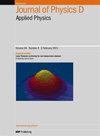具有高场效应迁移率(128.3 cm2 V-1 s-1)和低热预算(200 °C )的钝化氧化铟薄膜晶体管
IF 3.2
3区 物理与天体物理
Q2 PHYSICS, APPLIED
引用次数: 0
摘要
在此,我们展示了一种具有溅射氧化铝(Al2O3)钝化层(PVL)的高迁移率氧化铟(In2O3)薄膜晶体管(TFT),该薄膜晶体管的热预算较低(200 °C)。Al2O3 PVL 的溅射工艺在改善 In2O3 TFT 的场效应迁移率 (µFE) 和电流导通/关断比 (ION/IOFF) 性能方面发挥了积极作用。然而,由于 In2O3 沟道中存在高密度的本征陷阱缺陷,因此这些性能的提高是有限的,这反映在其较大的滞后性和较差的偏压稳定性上。在溅射 Al2O3 PVL 之前,用氧(O2)等离子体处理 In2O3 沟道可以显著提高性能。具体来说,钝化 In2O3 TFT(采用 O2 等离子体预处理)实现了 128.3 cm2V-1 s-1 的高 µFE、在 0.1 V VDS 条件下超过 106 的高 ION/IOFF、0.03 V 的小滞后以及负偏压条件下可忽略不计的阈值电压偏移,与钝化 In2O3 TFT(未采用 O2 等离子体预处理)和未钝化 In2O3 TFT 相比有了显著改善。经二氧化硫等离子体补偿的钝化 In2O3 TFT 本征陷阱缺陷明显减少,这是 µFE 和偏压稳定性得到改善的主要原因,X 射线光电子能谱、滞后分析和温度应力电特性分析都验证了这一点。等离子体处理与溅射钝化相结合,可有效补偿氧化物半导体(OS)沟道中的固有阱缺陷,从而显著提高 OS TFT 在低热预算下的整体性能。这种方法为开发具有令人满意的驱动能力和广泛适用性的 OS TFT 提供了宝贵的见解。本文章由计算机程序翻译,如有差异,请以英文原文为准。
Passivated indium oxide thin-film transistors with high field-effect mobility (128.3 cm2 V−1 s−1) and low thermal budget (200 °C)
Here, we demonstrate a high-mobility indium oxide (In2O3) thin-film transistor (TFT) with a sputtered alumina (Al2O3) passivation layer (PVL) with a low thermal budget (200 °C). The sputtering process of the Al2O3 PVL plays a positive role in improving the field-effect mobility (µFE) and current on/off ratio (ION/IOFF) performance of the In2O3 TFTs. However, these enhancements are limited due to the high density of intrinsic trap defects in the In2O3 channels, as reflected in their large hysteresis and poor bias stability. Treating the In2O3 channel with oxygen (O2) plasma prior to sputtering the Al2O3 PVL results in notable improvements. Specifically, a high µFE of 128.3 cm2V−1 s−1, a high ION/IOFF over 106 at VDS of 0.1 V, a small hysteresis of 0.03 V, and a negligible threshold voltage shift under negative bias stress are achieved in the passivated In2O3 TFT (with O2 plasma pretreatment), representing a significant improvement compared to the passivated In2O3 TFT (without O2 plasma pretreatment) and the unpassivated In2O3 TFT. The remarkable reduction of intrinsic trap defects in the passivated In2O3 TFT compensated by O2 plasma is the primary mechanism underlying the improvement in µFE and bias stability, as validated by x-ray photoelectron spectra, hysteresis analysis, and temperature-stress electrical characterizations. Plasma treatment effectively compensates for intrinsic trap defects in oxide semiconductor (OS) channels, when combined with sputter passivation, resulting in a significant enhancement of the overall performance of OS TFTs under low thermal budgets. This approach offers valuable insights into advancing OS TFTs with satisfactory driving capability and wide applicability.
求助全文
通过发布文献求助,成功后即可免费获取论文全文。
去求助
来源期刊
CiteScore
6.80
自引率
8.80%
发文量
835
审稿时长
2.1 months
期刊介绍:
This journal is concerned with all aspects of applied physics research, from biophysics, magnetism, plasmas and semiconductors to the structure and properties of matter.

 求助内容:
求助内容: 应助结果提醒方式:
应助结果提醒方式:


